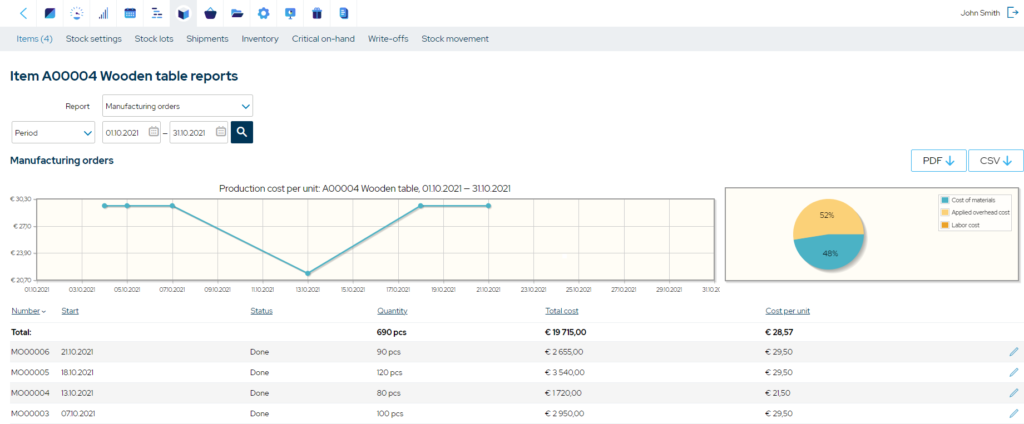What Is SKU Rationalization?
Determining which products to continue selling and which ones to discontinue is a challenge most businesses need to face at some point. Because there are many aspects to consider before cutting your product catalog, the process of SKU rationalization is here to help you find a balance between too many and too few SKUs.

You can also listen to this article:
What is SKU Rationalization?
SKU rationalization is the process of evaluating the marketability and profitability of your products and eliminating underperforming or obsolete stock-keeping units from the product catalog. This vastly helps in keeping your inventory and ordering processes optimized, and the overall health of your company in good shape.
In many manufacturing and distributing companies, new SKUs are continuously added to the product mix. This is called SKU proliferation and it seems completely logical to add items to your catalog to respond to customer demand. At some point, however, there will be a need to optimize the offerings in order to cut costs and be more efficient.
But SKU rationalization is not as easy as determining which items sell worse than others and then cutting them out. Different departments might have different ideas as to what constitutes a redundant product and if SKU rationalization is even required.
For example, the sales team might have the opinion that a large product mix could help the company cater to a larger number of customers and dominate the market. On the other hand, the operations department might want to reduce the number of SKUs in order to minimize inventory, streamline the processes, and cut costs. That is why SKU rationalization needs to stand on a firm analytical basis: to let the data decide which products to discontinue and which ones to keep.
SKU Rationalization benefits
Eliminating excess inventory is always a good idea and SKU rationalization is often one of the best things you can do for your business. Here are some of the benefits it offers:
- Inventory cost reduction. Optimizing your SKUs will help minimize your inventory, which means wasting less money, space, and labor on goods that bring insufficient returns.
- Better warehouse organization. The more goods you stock, the more cluttered your stockroom becomes. Minimizing your SKUs is a good basis for better warehouse organization.
- Improved efficiency. Better warehouse organization also leads to more efficient process flow in the stockroom. With fewer items to manage, everything from inventory analytics to picking will become more efficient.
- More cash available. The savings and a healthier cash flow created by SKU rationalization can be put to good use elsewhere. For example, you might want to increase your marketing budget or invest in research and development.
- Less dead stock. SKU rationalization can help discontinue underperforming products before they become dead stock, i.e. obsolete inventory. Having fewer items in inventory can also prevent the expiration of some merchandise.
- Increased profits. All of the abovementioned benefits of SKU rationalization will help minimize costs and bolster up your bottom line.
SKU Rationalization process
1. Review your target market
First of all, you will need to check whether all your offerings and their unique selling points align with the needs of your target market. Ask yourself:
- Who is my target audience?
- What are their needs?
- Which problems do our products intend to solve for them?
- What kind of products are they most interested in?
If there are products that do not sell well and seem out of place considering your target audience, it is a clear sign that they should be discontinued. For products that do align with the needs and wants of your target market, continue with the next step.
2. Analyze your SKUs
There are many aspects to consider when analyzing your inventory for SKU rationalization. You need to find out whether your SKUs are balanced in their:
- Consumption value (units sold x cost per unit)
- Consumer demand
- Production costs
- Inventory costs
- Inventory turnover
- Return rates
- Lead times
Analyzing these aspects of an SKU will give you a good idea about the performance of the product and whether you should continue to manufacture and sell it or, conversely, discontinue it.
Even though it may seem difficult to evaluate all of those factors, you can derive most of this information from the data in your ERP/MRP system.

3. Identify product cannibalization
SKU proliferation may lead to you having multiple similar products in your catalog that all compete for the business of the same target market. Even though you may think that adding additional SKUs with small tweaks into your product line can help you corner the segment, it can sometimes just lead to higher costs and low sales for all products involved. This is called product cannibalization – an apt name for when your new product eats away the sales of your existing product instead of doing it to your competitors.
4. Consider your competitors
When performing SKU rationalization, you should always also consider what your competitors are doing that might have an impact on the performance of your products. Perhaps they are running a marketing campaign that is pulling your customers away or maybe they have lowered their prices. In these cases, the issue is not in your products, therefore there is no need to eliminate them from the catalog. Rather, you should try and respond with similar measures – with stronger marketing efforts or a renewed pricing policy. SKU rationalization does not have to be a life or death question for your SKUs. In some situations, a simple price adjustment can do wonders for the performance of a product.
5. Analyze marketing per SKU
Before weeding out your catalog with SKU rationalization, you should also consider the marketing efforts that are put into the SKUs. While one product might show good performance and another one low sales, the marketing budget allocated towards them might also be drastically different. The low performance of a product might not be because the product has no market value, but rather because the marketing behind the product is lacking.
6. Reorganize your product catalog
If you have analyzed all the previous aspects, you should have a clear overview of which SKUs are worth keeping and which ones you should discontinue. Ideally, you should categorize your SKUs into three categories:
- A – products to keep
- B – products to review
- C – products to discontinue
While what you should do with the A and C class items is clear, the B-category items are in the middle ground. That means you should keep them, but re-analyze them more often than A-class items. You do not want to eliminate products that are not performing that great but that some of your customers are still consistently buying as this may drive those customers away to another company that offers them everything they need. Start with eliminating obsolete items and slowly move forward with the SKU rationalization.
7. Repeat the SKU Rationalization process periodically
Once you have shed the extra fat from your product catalog, you should be left with a more focused and efficient business process. That, however, does not mean that your company will be in its best shape for the foreseeable future.
SKU rationalization should be a continuous process that would allow you to analyze trends and review your SKUs periodically. Measuring the results of the SKU rationalization is also key in improving the process even further. If you have lowered your operational costs and reduced your inventory without it negatively affecting your revenue, you have done a great job. Now it would be a good idea to review the SKUs every six months to a year.
Key takeaways
- SKU rationalization is the process of evaluating the marketability and profitability of your products and eliminating underperforming or obsolete stock-keeping units from the product catalog.
- This is done in order to minimize inventory, reduce ordering and holding costs, and make business processes as lean as possible.
- SKU rationalization has many benefits, including inventory cost reduction, better warehouse organization, improved efficiency, cash flow improvement, reduction of dead stock, and increased profits.
- The SKU rationalization process requires you to review your target market, analyze the performance of your SKUs, identify product cannibalization, consider the efforts of your competitors, and analyze your own marketing efforts in relation to specific SKUs. Only then should you choose which products to discontinue.
- SKU rationalization can be regarded as a success when operational costs have been lowered and inventory minimized without it affecting the revenue.
- To keep your product catalog and your company in good shape, SKU rationalization should be repeated periodically – from every 6 months to a year.
You may also like: Mass Customization – A Viable Option for Small Manufacturers




